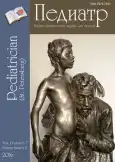The possibility of reducing mortality in the neonatal intensive care unit
- Authors: Asherova-Jushkova D.V1, Kovaljova M.A1, Chaparova T.V2, Shmeljova A.A2, Gorodova E.V2, Ljasthenko A.Y.2, Badanina Y.S2, Protasova M.O2, Pelevina A.A2, Kocheshkov S.N2
-
Affiliations:
- State Budgetary Institution of Healthcare of Yaroslavl Region “Regional Perinatal Center”
- St Petersburg State Pediatric Medical University of Ministry of Health of the Russian Federation
- Issue: Vol 7, No 2 (2016)
- Pages: 40-46
- Section: Articles
- URL: https://journals.eco-vector.com/pediatr/article/view/3620
- DOI: https://doi.org/10.17816/PED7240-46
- ID: 3620
Cite item
Abstract
Keywords
Full Text
About the authors
Dar’ja V Asherova-Jushkova
State Budgetary Institution of Healthcare of Yaroslavl Region “Regional Perinatal Center”
Email: dasherova@yandex.ru
Head of Department of Neonate Intensive Care Unit
Marina A Kovaljova
State Budgetary Institution of Healthcare of Yaroslavl Region “Regional Perinatal Center”
Email: priemnaya.optz@yandex.ru
anesthesiologist-resuscitator of Department of Neonate Intensive Care Unit
Tatjana V Chaparova
St Petersburg State Pediatric Medical University of Ministry of Health of the Russian Federation
Email: tatyana.chaparova@gmail.com
Postgraduate Student, Department of Obstetrics & Gynecology
Anna A Shmeljova
St Petersburg State Pediatric Medical University of Ministry of Health of the Russian Federation
Email: niura.schmeliova@yandex.ru
Postgraduate Student, Department of Obstetrics & Gynecology
Elena V Gorodova
St Petersburg State Pediatric Medical University of Ministry of Health of the Russian Federation
Email: e.gor.24@mail.ru
Postgraduate Student, Department of Obstetrics & Gynecology
Anatolii Yu Ljasthenko
St Petersburg State Pediatric Medical University of Ministry of Health of the Russian Federation
Email: lyashenko70@mail.ru
Postgraduate Student, Department of Obstetrics & Gynecology
Yulia S Badanina
St Petersburg State Pediatric Medical University of Ministry of Health of the Russian Federation
Email: yulya-badanina@mail.ru
Postgraduate Student, Department of Obstetrics & Gynecology
Marina O Protasova
St Petersburg State Pediatric Medical University of Ministry of Health of the Russian Federation
Email: priemnaya.optz@yandex.ru
Postgraduate Student, Department of Obstetrics & Gynecology
Anna A Pelevina
St Petersburg State Pediatric Medical University of Ministry of Health of the Russian Federation
Email: pelevinaaa87@mail.ru
Postgraduate Student, Department of Obstetrics & Gynecology
Sergei N Kocheshkov
St Petersburg State Pediatric Medical University of Ministry of Health of the Russian Federation
Email: sergej-kocheshkov@yandex.ru
Postgraduate Student, Department of Obstetrics & Gynecology
References
- Ионов О.В., Рындин А.Ю., Антонов А.Г., и др. Сурфактантная терапия в комплексном лечении респираторной патологии у глубоко недоношенных детей // Российский вестник акушера-гинеколога. - 2013. - № 3. - С. 108-114. [Ionov OV, Ryndin AY, Antonov AG, et al. Surfactant therapy in complex treatment of respiratory disease in extremely premature infants. Rossiyskiy vestnik akushera-ginekologa. 2013;3:108-114. (In Russ).]
- Göpel W, Kribs A, et al. (German Neonatal Network) Less invasive surfactant administration is associated with improved pulmonary outcomes in spontaneously breathing preterm infants. Acta Paediatr. 2015; 104(3):241-6. doi: 10.1111/apa.12883.
- Klebermass-Schrehof K, Wald M, Schwindt J, et al. Less Invasive Surfactant Administration in Extremely Preterm Infants: Impact on Mortality and Morbidity. Neonatology. 2013;103:252ß258.
- Lin PW, Stoll BJ. Necrotising enterocolitis. Lancet. 2006; Oct 7;368(9543):1271ß83.
- Stevens TP, Blennow M, Meyers EH, Soll RF. Early surfactant administration with brief ventilation vs. selective surfactant and continued mechanical ventilation for preterm infants with or at risk for respiratory distress syndrome. Cochrane Database Syst Rev. 2007;4:CD00306. doi: 10.1002/14651858.cd003063.pub3.
Supplementary files








